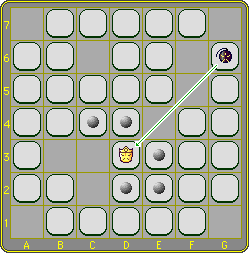Page 3 of 33
Shakti
 | This is without doubt the smallest chess game with a non trivial strategy. In the initial position the board is covered with 45 tiles. During play this number is bound to be reduced due to the 'atlantis effect', a mechanism that lies at the core of this miniature, and without which no such reduction in material would ever be possible.
|
 |
|
 |
|
 | The mutual check rule:
|
 | The Warrior:
|
External links
- ig Game Center (live play)Scroll down to play @ iG Game Center
- A Shakti program for the MacA free downloadable Mac program by Joe Strout.
- Shakti @ The Chess Variant Pages
- Shakti's entry @ BoardGameGeek
Shakti © MindSports
Java applet © Ed van Zon
